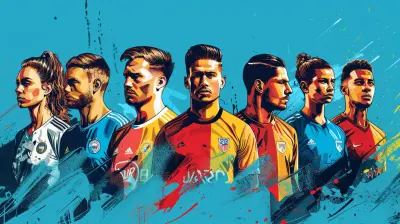The Role of Technology in Modernizing Club Team Operations
26 June 2025
Sports teams have come a long way from paper-based analytics and gut-feeling decisions. The digital revolution has transformed the way club teams operate, allowing them to function more efficiently on and off the field. From tactical analysis to fan engagement, technology has embedded itself into every aspect of modern sports.
But how exactly is tech reshaping club team operations? Let’s break it down.

1. Data Analytics: The Brain Behind Team Strategy
If there’s one game-changer in club team operations, it’s data analytics. With the rise of artificial intelligence (AI) and machine learning, teams now have access to detailed insights that were once impossible to obtain.Game Performance Analysis
Gone are the days when coaches relied solely on their eyes to assess player performance. Now, software tools track every move a player makes, offering real-time data on:- Passing accuracy
- Distance covered
- Sprint speed
- Shooting efficiency
This means decisions are now based on solid numbers instead of hunches. Think of it as the difference between driving with GPS versus blindly guessing your route.
Injury Prevention and Player Health
Wearable tech—like GPS trackers and heart rate monitors—helps teams monitor player exertion levels. By analyzing this data, medical teams can detect early signs of fatigue or injury risks. No more pushing a star player too far and regretting it later.Opposition Scouting
Technology has made scouting opponents easier than ever. Advanced video analysis software breaks down an opponent’s patterns, strengths, and weaknesses. This allows teams to craft tailored strategies, increasing their chances of success on the field.
2. Digital Transformation in Team Management
While performance analysis is crucial, the operational side of running a club team can’t be ignored. Thankfully, tech is making management smoother than ever.Cloud-Based Communication and Scheduling
Managing a sports team means dealing with schedules, meetings, training sessions, and event planning. Using cloud-based platforms like Google Drive, Asana, or Slack keeps everyone on the same page, allowing:- Real-time schedule updates
- Instant communication between staff and players
- Access to training materials anytime, anywhere
No more last-minute confusion over game times or miscommunication between departments.
AI-Powered Recruitment
Player scouting has gone digital too. AI-driven scouting platforms analyze thousands of players based on statistics, skills, and potential to find the best fit for a club. Instead of weeks of physical scouting trips, analysts can filter top prospects within minutes.
3. Fan Engagement: Bringing Supporters Closer to the Club
A club team isn’t just about the players—it thrives on its fans. With the rise of social media and digital engagement tools, clubs can now connect with their supporters like never before.Social Media and Live Updates
Fans expect instant updates, whether it’s match scores, player signings, or behind-the-scenes content. Platforms like Twitter, Instagram, and TikTok help clubs keep their supporters informed and engaged.Engaging content strategies include:
- Player Q&A sessions
- Live match-day coverage
- Exclusive behind-the-scenes videos
Club Apps and Membership Portals
Many modern clubs have their own mobile apps where fans can:- Buy tickets
- Watch exclusive content
- Access loyalty rewards
- Get real-time match updates
It’s like having the club in your pocket, making the fan experience more immersive than ever.
Augmented Reality (AR) and Virtual Reality (VR) Experiences
Some teams are even experimenting with AR and VR, allowing fans to experience stadium tours or even watch matches from a virtual front-row seat. It's like stepping into the game without leaving your couch.
4. E-Commerce and Merchandising: A Digital Revenue Stream
Merchandise sales have always been a crucial part of a club’s revenue. Thanks to e-commerce, selling jerseys, scarves, and other gear is easier than ever.Online Stores and Customization
Fans can now order personalized merchandise online with just a few clicks. Many clubs offer jersey customization, allowing supporters to have their favorite player’s name—or even their own—printed on the back.Blockchain and NFTs in Sports Merchandising
Blockchain is revolutionizing digital collectibles. Teams are now selling NFTs (non-fungible tokens) that grant fans exclusive digital memorabilia, like unique goal celebrations or limited-edition artwork. While some still see NFTs as a trend, they’re quickly becoming a high-value asset in sports marketing.5. Smart Stadiums: Enhancing the Match-Day Experience
A fan’s experience at the stadium isn’t just about the game—it’s about the entire atmosphere. Technology is stepping in to make match days smoother and more enjoyable.Mobile Ticketing and Contactless Payments
Paper tickets are becoming a thing of the past. Now, digital tickets and contactless payments allow fans to enter stadiums hassle-free. No more long queues at ticket booths or dealing with lost paper stubs.AI-Powered Crowd Management
Smart cameras and AI systems help monitor crowd movement, improving security and ensuring smooth entry and exit flows. This not only enhances safety but also reduces congestion in and around stadiums.5G-Powered Instant Replays
Thanks to 5G technology, fans can now stream instant replays from their seats using club apps. Missed a crucial goal? Just rewind on your phone and relive the moment in high definition.6. The Role of Esports in Club Expansion
Traditional sports teams are no longer just about physical matches. Many clubs are expanding into esports, tapping into a younger, tech-savvy audience.Gaming Partnerships and Tournaments
Big clubs like Manchester City and Paris Saint-Germain have their own esports divisions, competing in games like FIFA and Fortnite. This strategic move:- Expands the club’s reach to a global audience
- Creates new revenue streams through sponsorships and streaming
- Engages younger fans who may not typically follow traditional sports
Virtual Training Sessions
Believe it or not, esports-style simulations are now being used in real-world training. Virtual reality can help footballers improve their decision-making without stepping onto a pitch. It’s like a video game—but with serious real-world benefits.The Future of Technology in Club Team Operations
Technology isn’t just a temporary phase—it’s the future. Clubs that fail to embrace digital transformation risk falling behind in terms of performance, fan relations, and overall growth.Looking ahead, we can expect:
- More AI-driven coaching tools
- Smarter stadiums with fully digital infrastructure
- Enhanced fan personalization using big data insights
- Greater integration of cryptocurrency in ticketing and merchandising
The world of sports is evolving, and technology is at the heart of this change. Whether you're a player, coach, or fan, one thing is certain—the game will never be the same again.
all images in this post were generated using AI tools
Category:
Club TeamsAuthor:

Umberto Flores
Discussion
rate this article
1 comments
Rivera Kline
In the digital age, clubs take flight, With tech as their compass, guiding the night. Data dances, strategies refine, Bridging hearts and minds, where passions align. From smart wearables to fans engaged, A new era dawns, where dreams are staged. Innovation breathes life—let the game be played!
July 17, 2025 at 8:41 PM

Umberto Flores
Thank you for capturing the essence of how technology transforms club team operations! Your poetic perspective highlights the exciting synergy between innovation and community engagement.


